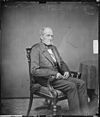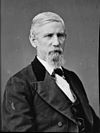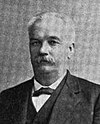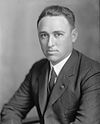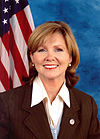| Tennessee's 7th congressional district | |
|---|---|
| Representative | Mark Green R–Clarksville |
| Population (2023) | 813,590 |
| Median household income | $74,881 |
| Ethnicity |
|
| Cook PVI | R+10 |
The 7th congressional district of Tennessee is a congressional district located in parts of Middle and West Tennessee. It has been represented by Republican Mark Green since January 2019. The seventh district has significant urban, suburban, and rural areas. Although most of the area is rural, more than half of the district's votes are cast in either Davidson County (Nashville), Montgomery County (Clarksville), or Williamson County (Franklin).
By most measures, Williamson County is the wealthiest county in the state and is usually ranked near the top nationally.
The district has a very strong military presence, as it includes Tennessee's share of Fort Campbell. Politically speaking, the area was secessionist and part of the Democrats' "Solid South" for a century after the Civil War, excluding heavily Republican Unionist Highland Rim Wayne County. Starting with the election of Don Sundquist in 1983, this district has become one of the most Republican areas in Tennessee. The presence of Nashville's suburbs gives it a character similar to those of most affluent suburban districts in much of the South until the mid-2000s. It has a strong social conservative bent; many of the state's most politically active churches are either located here or draw most of their congregations from here.
The rural secessionist counties are similar demographically to the 8th district and returned to the Democrats until the 2000s; three of the five Tennessee counties won by George McGovern lie within this district. However, since the mid-2000s, these counties have turned overwhelmingly Republican in all elections. Currently, the only Democratic stronghold in the district is part of Nashville, which was added during the 2020 redistricting cycle. The city of Clarksville is the most competitive part of the district, which still occasionally elects Democrats to the state legislature.
History
Districts stretching from Clarksville to West Tennessee have existed in one form or another since 1871. For most of the time, from 1933 to 1983 (except for 1943 to 1953), it was numbered as the 6th district.
This district assumed something approaching its current configuration in 1973, when Tennessee lost a congressional district. At that time, the 6th was redrawn to stretch from Williamson County, south of Nashville, to the eastern suburbs of Memphis and covering the rural areas in between. Republican Robin Beard represented this area from 1973 to 1983.
Tennessee gained a congressional district following the 1980 census. At this time, the district was re-numbered as the 7th and lost its eastern counties to the 4th and 6th districts. At the same time, most of its black residents closer to Memphis were drawn into the 9th district. Following this re-districting, Beard made an unsuccessful U.S. Senate bid, and was replaced by former Shelby County Republican Party chair Don Sundquist.
Sundquist served through the rest of the 1980s through the 1990 re-districting, which saw the district lose some of its rural counties while picking up Maury County. In 1994, Sundquist successfully ran for Governor of Tennessee, defeating future governor Phil Bredesen. Sundquist was then replaced by Ed Bryant. Bryant served from 1995 until 2002, when the district was gerrymandered by the Democrat-led Tennessee General Assembly to pack the consistently Republican suburbs of Nashville and Memphis into one district. The result was a district that was 200 miles (320 km) long, but only two miles (3.2 km) wide at some points in the Middle Tennessee portion. Following that re-districting, the area chose Brentwood-based state senator Marsha Blackburn. She served from 2003 to 2019.
Redistricting after the 2010 census made the district somewhat more compact, restoring a configuration similar to the 1983-2003 lines. However, it lost its share of the Memphis suburbs to the 8th, a move which made the 8th as heavily Republican as the 7th. In 2018, Blackburn successfully ran for the U.S. Senate, defeating former governor Phil Bredesen. In the concurrent election, the district selected doctor and former state senator Mark E. Green.
Redistricting after the 2020 census made the district somewhat less Republican. This was because Tennessee's legislature cracked Davidson County into 3 congressional districts to boost Republican support in the 5th district. The 7th district now obtains the western portion of Nashville while it lost some rural counties to the 8th district.
Despite the dramatic changes to the district's boundaries, the district is still considered safe Republican, with a Cook PVI of R+10. Republican Congressman Mark Green still represents the district to this day.
Current boundaries
The district is located in both West and Middle Tennessee. It stretches as far north as the Kentucky border, as far south as the Alabama border, as far east as Franklin, and as far west as Camden.
It is currently composed of the following counties: Cheatham, Dickson, Decatur, Hickman, Houston, Humphreys, Montgomery, Perry, Robertson, Stewart, and Wayne. It also includes significant portions of Benton, Davidson, and Williamson.
Recent election results
- Results under old lines (2013-2023)
| Party | Candidate | Votes | % | ||
|---|---|---|---|---|---|
| Republican | Marsha Blackburn (Incumbent) | 182,730 | 71.0 | ||
| Democratic | Credo Amouzouvik | 61,679 | 24.0 | ||
| Green | Howard Switzer | 4,640 | 1.8 | ||
| Independent | Jack Arnold | 4,256 | 1.7 | ||
| Independent | William Akin | 2,740 | 1.1 | ||
| Independent | Lenny Ladner | 1,261 | 0.5 | ||
| Total votes | 257,306 | 100 | |||
| Republican hold | |||||
| Party | Candidate | Votes | % | |
|---|---|---|---|---|
| Republican | Marsha Blackburn (incumbent) | 110,534 | 70.0 | |
| Democratic | Daniel Cramer | 42,280 | 26.8 | |
| Independent | Leonard D. Ladner | 5,093 | 3.2 | |
| Total votes | 157,907 | 100.0 | ||
| Republican hold | ||||
| Party | Candidate | Votes | % | |
|---|---|---|---|---|
| Republican | Marsha Blackburn (incumbent) | 200,407 | 72.2 | |
| Democratic | Tharon Chandler | 65,226 | 23.5 | |
| Independent | Leonard D. Ladner | 11,880 | 4.3 | |
| Total votes | 277,513 | 100.0 | ||
| Republican hold | ||||
| Party | Candidate | Votes | % | |
|---|---|---|---|---|
| Republican | Mark Green | 170,071 | 66.9 | |
| Democratic | Justin Kanew | 81,661 | 32.1 | |
| Independent | Leonard Ladner | 1,582 | 0.6 | |
| Independent | Brent Legendre | 1,070 | 0.4 | |
| Total votes | 254,384 | 100.0 | ||
| Republican hold | ||||
| Party | Candidate | Votes | % | |
|---|---|---|---|---|
| Republican | Mark Green (incumbent) | 245,188 | 69.9 | |
| Democratic | Kiran Sreepada | 95,839 | 27.3 | |
| Independent | Ronald Brown | 7,603 | 2.2 | |
| Independent | Scott Vieira | 2,005 | 0.6 | |
| Total votes | 350,635 | 100.0 | ||
| Republican hold | ||||
Results under current lines (2023-present)
| Party | Candidate | Votes | % | |
|---|---|---|---|---|
| Republican | Mark Green (incumbent) | 108,421 | 59.96% | |
| Democratic | Odessa Kelly | 68,973 | 38.14% | |
| Independent | Steven J. Hooper | 3,428 | 1.90% | |
| Total votes | 180,822 | 100.00% | ||
| Republican hold | ||||
| Party | Candidate | Votes | % | |
|---|---|---|---|---|
| Republican | Mark Green (incumbent) | 191,992 | 59.50% | |
| Democratic | Megan Barry | 122,764 | 38.05% | |
| Independent | Shaun Greene | 7,900 | 2.45% | |
| Total votes | 322,656 | 100.00% | ||
| Republican hold | ||||
Recent election results from statewide races
| Year | Office | Results |
|---|---|---|
| 2008 | President | McCain 50% - 48% |
| 2012 | President | Romney 55% - 45% |
| 2016 | President | Trump 56% - 39% |
| 2018 | Senate | Blackburn 50% - 49% |
| Governor | Lee 54% - 43% | |
| 2020 | President | Trump 56% - 41% |
| Senate | Hagerty 58% - 39% | |
| 2024 | President | Trump 60% - 38% |
List of members representing the district
Historical district boundaries


See also
References
- Center for New Media & Promotion (CNMP), US Census Bureau. "My Congressional District". www.census.gov. Retrieved February 1, 2024.
- "B03002: 2023 American Community Survey 1-year Estimates - Congressional District 7 (118th Congress), Tennessee". United States Census Bureau.
- Center for New Media & Promotion (CNMP), US Census Bureau. "My Congressional District". www.census.gov. Retrieved September 22, 2024.
- "2022 Cook PVI: District Map and List". Cook Political Report. Retrieved January 10, 2023.
- "7. Williamson County, TN (Median household income: $104,367)". Forbes. Retrieved January 28, 2021.
- "GOP redraws Nashville from 1 Democratic district into 3 Republican-leaning districts". WJCT News. July 26, 2022. Retrieved February 18, 2023.
- Witherspoon, Andrew; Levine, Sam (January 26, 2022). "A masterclass in election-rigging: how Republicans 'dismembered' a Democratic stronghold". The Guardian. Retrieved February 18, 2023.
- "2022 Cook PVI℠: District Map and List". Cook Political Report. July 12, 2022. Retrieved June 17, 2024.
- https://davesredistricting.org/maps#viewmap::9185d1ce-1556-46ab-9628-6749769d0262
- "2024 Tennessee Presidential election by congressional district". Dave's Redistricting. Retrieved January 14, 2025.
- Martis, Kenneth C. (1989). The Historical Atlas of Political Parties in the United States Congress. New York: Macmillan Publishing Company.
- Martis, Kenneth C. (1982). The Historical Atlas of United States Congressional Districts. New York: Macmillan Publishing Company.
- Congressional Biographical Directory of the United States 1774–present
| Tennessee's congressional districts | |
|---|---|
|
35°38′02″N 87°49′59″W / 35.63389°N 87.83306°W / 35.63389; -87.83306
Categories:
